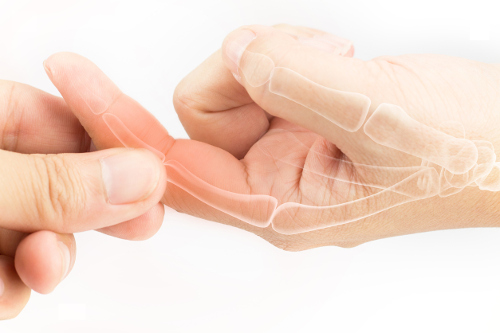 Having dactylitis or “sausage fingers” can be both embarrassing and painful. The dactylitis definition is simply the inflammation or swelling of the fingers or toes.
Having dactylitis or “sausage fingers” can be both embarrassing and painful. The dactylitis definition is simply the inflammation or swelling of the fingers or toes.
It can also have a debilitating effect as you may not be able to bend or move your digits as freely as required. Since dactylitis is usually an indication of a more serious underlying health concern, we are going to discuss why finger swelling occurs by examining the causes. We also have tips on how to reduce swelling of fingers.
Dactylitis is a form of the Greek word for daktylos, which means finger. The medical world uses the term to refer to all digits of the hand and foot. The condition is also known as “sausage fingers” as your finger or toe looks like a plump sausage when swollen.
What Are the Causes of Dactylitis?
Dactylitis is a condition involving several health diseases and disorders relating to the joints and tissues of the hands and feet. It is usually the result of blocked blood circulation or an infection in the flexor tendon sheath. Let’s look at what causes sausage fingers.
1. Sickle Cell Disease
This disease covers an inherited group of blood disorders, with sickle cell anemia being the most common. Sickle cell anemia signals a lack of healthy red blood cells. As a result, there is insufficient oxygen, which causes the misshaped red blood cells to block circulation within the blood vessels. Dactylitis is just one effect of this condition.
2. Psoriatic Arthritis
As one of the more common causes of sausage digits, psoriatic arthritis (PSA) is an autoimmune disease. This chronic condition occurs when the immune system mistakenly attacks the healthy tissues. Inflammation of the skin and joints is the resulting factor of PSA.
PSA affects more than 30% of all patients suffering from psoriasis. And, dactylitis is found in more than 50% of these cases. This form of arthritis has five different types known as asymmetric oligoarthritis, symmetric polyarthritis, distal arthritis, spondyloarthritis, and arthritis mutilans.
3. Rheumatoid Arthritis
This autoimmune disease is also known as RA, where the immune system attacks the joints. While RA is not a direct cause of dactylitis, it does result in sausage fingers. Swelling can be seen in the hands and feet, as well as the wrists, knees, and ankles.
4. Reactive Arthritis
Reactive arthritis is often the result of an infection stemming from the intestines, urinary tract, or genitals. It is initially caused by bacteria such as Salmonella, Yersinia, Shigella, or Campylobacter. These forms of bacteria can be easily transmitted by sexual contact or contracted through food.
Dactylitis Symptoms
As the name implies, dactylitis causes swelling of the fingers or toes. This inflammation results in other symptoms like fever and can make it difficult to use the hands and even walk.
1. Inflammation
The swelling of fingers and toes can happen suddenly, either individually or at the same time, depending on the underlying cause. The inflammation may even result in the inability to move or bend the affected digits. It also causes the affected region to be warm to the touch as the blood collects in the area.
2. Pain
The inflammation can lead to severe pain in the fingers or toes. It may radiate to nearby digits or the palm, as well as the entire surface of the foot. Not only does the inflammation make it difficult to move the affected region, but the pain can also be enough to make the patient avoid using the hand or foot.
3. Tenderness
Inflamed joints can experience tenderness to the touch. Doctors will use tenderness as a diagnostic tool to evaluate the level of the dactylitis on a scale of zero to three.
At the zero level, the patient will not have any tenderness upon squeezing the swollen digit. A score of one indicates tenderness, while level two shows tenderness with grimacing when squeezing the digit. At the highest level, the sufferer has severe tenderness and retracts their digit when touched.
Diagnosis of Dactylitis
A series of tests may be conducted to determine the underlying health condition causing dactylitis. The doctor will complete a physical examination of the affected region, as well as discuss patient’s medical and family history.
Tests that may help with a diagnosis include a complete blood count test, a lung examination, x-rays, a magnetic resonance imaging (MRI) test, or a joint fluid test.
Dactylitis Treatment
Effective treatment of dactylitis will be dependent on the cause of the swelling. Once the doctor makes a diagnosis and discovers the underlying health condition, he or she may recommend treatments to target the condition.
For instance, if a bacterial infection is to blame, you may be prescribed antibiotic medication to combat the infection, inflammation, and pain together. You may also need to take antibiotics with a dactylitis condition that results in blisters or lesions. In these cases, an incision is usually made to drain the fluid.
You may want to use a couple of home remedies to deal with the inflammation and pain. For example, drinking plenty of water and clear fluids will target swollen and puffy fingers. Hot or cold compresses can also help with inflammation, as well as reduce pain. However, if your pain is severe, you may want to ask for prescribed pain relief medication.
Dactylitis can become a debilitating condition if the inflammation is severe enough to cause intense pain when moving the fingers or toes. A serious underlying health condition affecting your bloodstream or healthy tissues can result in sausage fingers. Symptoms of swelling and pain can last for weeks, if not months for some sufferers. Most cases require minor treatment unless caused by a severe disorder. Many patients find relief with anti-inflammatory treatment.
Sources:
“Dactylitis: Sausage Fingers,” Healthline; http://www.healthline.com/health/rheumatoid-arthritis/dactylitis#overview1, last accessed July 6, 2017.
